|
April 24, 2008
Presenting: Brandon Wilson - Author, Photographer
and World Traveller Shares Tales of a Pilgrim
As I have gotten older I have found myself getting increasingly
disenchanted with my regular rat-race life, and I have actively
searched out individuals who have walked a different path. On my
website you will find many people who have quit their corporate
jobs and created new lives, much more spiritual and meaningful lives
that are not dominated by the quest for consumption and material
gain.
One of these people is author and photographer Brandon Wilson. Read
here about his unique path and his special insights as a world traveler
and pilgrim.
1. Please tell us about yourself. Where are you from, what
is your background?
I grew up in Pennsylvania’s Ohio Valley, went to university
in the South, and have been moving farther and father west throughout
my life. Now I live in Hawaii. If I head west again, I run the risk
of starting all over again as I cross the International Date Line.
I’m facing a weird time-space dilemma.
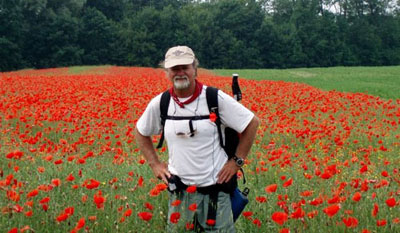
Brandon Wilson, author/pilgrim, amid the poppies of Hungary
Image © Brandon Wilson
2. Some events shaped you and kindled a passion for travel
when you were very young. Please tell us more.
I discovered the freedom and addictive lure of travel at an early
age. When I was six years old, my father and I set off across America
in a red and white Chevy with a burlap bag full of water strapped
to the grill. To a bright-eyed kid, there was something magical
about the open road, not knowing what lies around the next bend.
Hey, there still is. My father and I feasted on a now-extinct America
along Route 66, complete with teepee motels, plastic cactuses, and
characters straight out of a Tarantino film. I was hooked. That
trip planted a seed in my fertile imagination that grew into a passion
for travel and exploration.
3. In the 1980s you decided to change your life. What were
you doing before, what made you want to make a change and how was
your transition to a more unconventional life?
Up until that point, like many people, my chance to get away was
limited by my job, bank account and perceived responsibilities.
I’d been trained in communications and tried to fit into the
bizarre mold (or algae) of the corporate world. Well, I never adapted
well to cubicle-life. Thank God. I ended up on the creative end
of the biz, but even then I realized that this was like dressing
a pig in pajamas. It was still a pig.
In the mid-80s, my wife Cheryl and I quit our jobs in a remote
Arctic Eskimo village, bought a round-the-world air ticket and took
off for a year. It was a chance to defrost as we worked our way
though a mental checklist of all the places we’d ever dreamed
of exploring: from India’s Taj Mahal to the tombs of Luxor
to the nude beaches of Greece and spas of Japan. It was an exhaustive
and eclectic list.
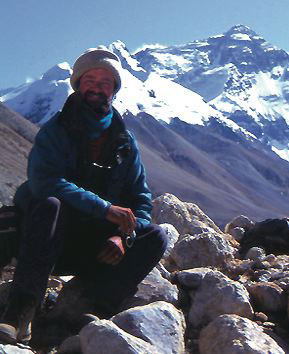
Brandon Wilson at Mt. Everest base camp
Image © Brandon Wilson
Traveling on just $30 a day, we learned how to travel and live
like a local wherever we landed. That was a valuable lesson, as
it easily dispelled the myth that you have to be “rich”
to travel. Independent travel was far better anyway than being stuck
in a tour group and surrounded by all the folks you hoped to avoid
at home. Besides, it was a lot more fun to hop a ride on a Thai
train, teach “Row, Row, Row Your Boat” to local guys
and buy grilled kabobs out the window.
4. Your first big pilgrimage happened in 1992: you and your
wife went to Tibet. Why did you decide to go on this trip?
Honestly, at first it appealed to us as the ultimate adventure.
We’d grown up with the mystery of Tibet. The Land of Snows
had been cloistered for so many centuries. After the Chinese invasion
in 1950, its borders had been closed off and on for decades. Travel
was limited to a few propaganda-laden tours.
So there was little surprise when we applied for a visa and were
told that it was an “impossible” journey: there was
no food, no place to stay, no maps, extreme weather, nose bleed
altitudes, no way to communicate, yada yada. The more the Chinese
insisted it was “impossible,” the more I wanted to do
it. To top it all off, visas weren’t being issued. So we decided
to go to Nepal and apply again there. If we couldn’t get a
visa, we’d sneak in and move from village to village relying
on fate or karma.
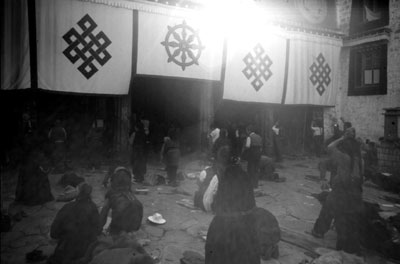
Prostrating Pilgrims in a cloud of incense, Jokhang Temple,
Lhasa, Tibet
Image © Brandon Wilson
As luck would have it, in Katmandu we discovered the border opened
just the day before—for the first time in decades. Synchronicity.
The Chinese gave us sixty-day visas. Their only restriction was
that we’d have to take their tour in Lhasa, but then we could
walk 1,000km back to Katmandu along an ancient Buddhist pilgrimage
trail.
Even before we left the Himalayan capital, we were surrounded by
soldiers and reminded of the harsh conditions facing Tibetans today
with their brutal occupation. So we bought a set of prayer flags
with the intent of presenting them to the King of Nepal—if
we made it back to Katmandu—in the hope he would fly them
as a symbol of solidarity with the Tibetan people.
5. Please tell us about some of the practicalities involved
in this trip: what about luggage, where did you sleep, how did you
deal with the physical demands of this experience?
We carried backpacks with a tent and sleeping bags, plus all the
gear you’d expect on a Himalayan expedition at 12-17,000 feet.
However, we only took five days worth of food, expecting to buy
more along the way. Just outside of Lhasa, we bought a Tibetan horse
named Sadhu, who quickly became our buddy and a terrific icebreaker
with the locals.
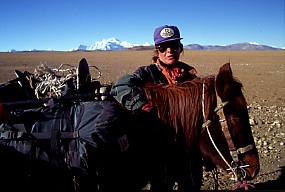
Cheryl and Sadhu adrift on the wild Tibetan plains.
Image © Brandon Wilson
6. Please tell us about your route and some of the complications.
In 1992, things were much different than they are today. Most of
the east-west road was gravel and poorly marked. The “latest”
maps didn’t even show the airport. Over the next forty days
we found ourselves a little lost, we were shot at by Chinese soldiers,
we walked through a blizzard, puked from a bronchial infection,
I cracked a rib from coughing over a dung fire, plus it was always
uncertain where (or if) we’d find food, water or a place to
sleep. Much to our chagrin, there were very few stores or markets
along the way and I quickly lost 25% of my body weight. (As a weight
loss plan though, I really can’t recommend it.)
7. What about your experiences with the locals? What did
you learn about Tibetan culture?
All those difficulties made us more dependent on the kindness of
strangers. As it turned out, we only used our tent two nights. The
rest of the time we were invited into locals’ homes. We slept
on their floors or in their courtyards or stables and often shared
a cup of yak butter tea with them. Many of them were former monks
and spoke a smattering of English. In secret, they’d unveil
their altar and speak of their steadfast faith in the Dalai Lama’s
return. I was astounded by their unshakable faith and have since
become a staunch supporter of their human rights.
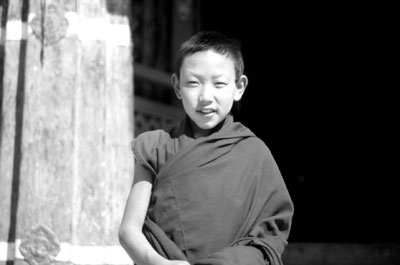
Young Lhasa monk. Image © Brandon Wilson
8. What did you learn from this experience and how has
it affected your life?
It taught us the beauty of slow, deliberate travel. Discovering
a place and culture by walking is such an entirely different experience
than traveling by car or even bicycle. It slows down reality and
allows you to wallow in the minutiae. You reconnect with the earth
and have time to work through harbored feelings, ideas and emotions.
You disconnect from the frenzy of the modern world and reconnect
to the more natural one. Walking becomes a Zen-like transcendent
experience, a trampoline for the mind.
9. Please tell us about the book you wrote about this experience
"Yak Butter Blues".
Each day along the way, I wrote about our experiences while they
(and the blisters) were still fresh. I described the unique people
we met as well as the thoughts passing through my sun-addled brain.
The award-winning book is a true story of our survival interwoven
with that of the Tibetan people. It is candid, gritty and provides
an intimate look at a culture facing extinction. We feel honored
to have preserved this moment in time and felt a responsibility
to set adrift this message in a bottle so that others can discover
an inspiring glimpse of the Tibetan people’s courage for themselves—hopefully
before it’s too late.
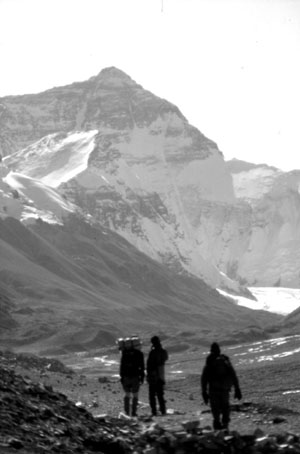
In Everest's Shadow approaching the North Face
Image © Brandon Wilson
10. You also did some extensive travelling through Africa
and wrote another book "Dead Men Don't Leave Tips". What
was this trip all about?
Following our year circling the globe, we returned to the States,
easily choosing Hawaii as a more temperate and tolerant location.
Still we only lasted another four years before wanderlust struck
again. Cheryl and I quit our “career” jobs, sold our
house and cars, put everything into storage and set off once again
for the unknown.
After backpacking across Eastern Europe on a shoestring for a few
months, we landed in Berlin just in time to help chip away at the
Wall. Then determined to explore Africa, we joined a do-it-yourself
safari out of London bound for Cape Town. We figured crossing seventeen
countries over seven months would be enough of a challenge without
having to deal with all the bureaucracy and baksheesh along the
way. So we’d let the “experts” handle that. What
a mistake. In theory that made sense, but our expert driver and
his assistant were as new to Africa as we were. We soon decided
we’d rather risk dying at our own hands rather than theirs
and set off on our own.
All in all, it was a wild experience as we traversed an unpredictable,
ever-changing continent. We crossed the Sahara, went whitewater
rafting down the Zambezi, climbed “Kili,” hunted dik-dik
in a Pygmy village, photo stalked mountain gorillas and hopped the
gun-run across Mozambique during its civil war. And that was just
the beginning… Besides providing a great series of adventures,
quirky characters and comic mishaps, the book allows readers to
experience the diversity of Africa while adding a human face to
a misunderstood continent.
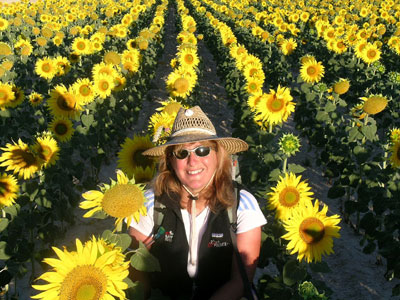
Quiet moments in fields transport you to simpler times
Image © Brandon Wilson
11. A few years later you embarked on the famous Camino
de Santiago pilgrimage in Northern Spain. Please tell us more about
that experience.
Our Tibetan odyssey really changed the way we looked at travel.
It was such an intense experience. Upon returning I found myself
seeking something that might begin to compare. By chance, I heard
about a medieval route that crossed Spain from the French border
to Santiago de Compostela and the burial place of St. James the
Apostle. So by the fall of 1999, I gladly set off with a backpack
and joined others from around the world on this ancient path.
For the beginner pilgrim, or peregrino, days are certainly more
organized than in Tibet. The trails are well marked, the scenery
is varied and beautiful, there are inexpensive hostels to stay each
night, and plenty of small cafes and good local wine to satisfy
your hunger. Yet again, there is that rare chance to disconnect
from the din and clutter of the outside world, to travel outside
while traveling within.
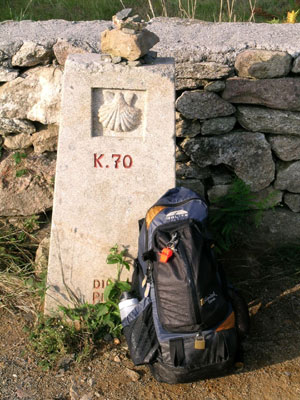
The way to Santiago is well-marked and well-trodden
Image © Brandon Wilson
12. You also covered the Via Francigena from Canterbury
to Rome. Why did you choose this pilgrimage route and what did you
experience?
The pilgrim’s cape fit me well. Walking on pilgrimage trails
became my passion. I no sooner returned from Santiago than I started
thinking about my next walk. Of course, in between I had to earn
a living at writing, but my mind was never far from the trail. Before
long, I heard about another path that had recently been re-established.
It followed the route of Sigeric, Archbishop of Canterbury, from
England to Rome. So, over two summers I retraced his journey, walking
one year from Switzerland to Rome and another from Lausanne to England.
I discovered the same serenity on the trail and the same friendliness
and curiosity by locals along the way—and the red wine was
a vast improvement over yak butter tea. They tell me that I’m
the first American to walk that trail and hopefully my notes and
mentoring make it more feasible for others to follow.
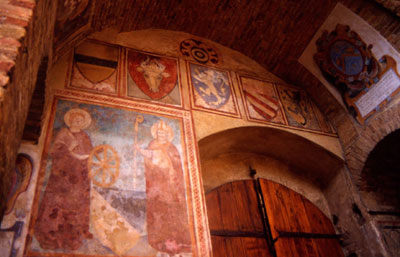
San Gimignano preserves its medieval heritage down to the smaller
details. Image © Brandon Wilson
Stay tuned for Part
II of this interview where Brandon will tell us about his pilgrimage
from France to Jerusalem and many other fascinating experiences.
Brandon Wilson’s books are available from your favorite bookstore
or Internet bookseller. For previews and free pdf articles about
the trails mentioned, visit: http://www.pilgrimstales.com.
Photos from his walk to Jerusalem may be viewed at:
http://www.youtube.com/watch?v=8pJaLpWZWbU
Useful Books:
|